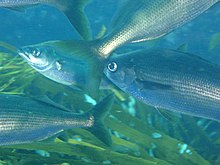| Latridae | |
|---|---|

| |
| Striped Trumpeter, (Latris lineata), on a deep reef in the Flinders Commonwealth Marine Reserve, northeast Tasmania - depth 160 m | |
| Scientific classification | |
| Domain: | Eukaryota |
| Kingdom: | Animalia |
| Phylum: | Chordata |
| Class: | Actinopterygii |
| Order: | Centrarchiformes |
| Suborder: | Cirrhitoidei |
| Family: | Latridae T. N. Gill, 1862 |
| Genera | |
|
see text | |


Latridae commonly called trumpeters, is a family of marine ray-finned fish. They are found in temperate seas in the Southern Hemisphere. The classification of the species within the Latridae and the related Cheilodactylidae is unclear.They are fished commercially and for sport.
Taxonomy
Latridae is classified within the superfamily Cirrhitoidea, under the suborder Percoidei of the large order Perciformes. Molecular studies have also placed the superfamily within the order Centrarchiformes, although the Cirrhitoidea is confirmed as a monophyletic clade. The 5th Edition of Fishes of the World does not recognise Centrarchiformes and retains the superfamily within the order Perciformes. The family has three genera according to the 5th Edition of Fishes of the World, however the authors of that book admit that further studies need to be carried out to resolve the true relationships of all the taxa within the Cirrhitoidea. Latridae was first formally desecrribed as a family in 1862 by Theodore Nicholas Gill.
The traditional delimitation of this family and Chaeilodactylidae is based on morphological differences, but the reliability of these differences has been questioned, and genetics do not support this treatment, either, leading some to suggest the majority of species traditionally classified as Cheilodactylidae should be placed within Latridae. Based on this, the only species that should remain in the family Cheilodactylidae are the relatively small Cheilodactylus fasciatus and C. pixi from southern Africa. This also means the broader definition of the genus Cheilodactylus is polyphyletic. All other species traditionally placed within the genus "Cheilodactylus" clearly do not, according to these analyses, belong with these two in Cheilodactylus and instead appear to belong in several different genera within Latridae, but how many and their exact delimitation is not clear at present.
Genera
The traditional classification places the following three genera in the family Latridae:
- Latridopsis Gill 1862
- Latris Richardson, 1839
- Mendosoma Guichenot 1848
The revised classification sensu Ludt, Burridge and Chakrabarty 2019 is:
- **Chirodactylus Gill, 1862
- Dactylophora De Vis, 1883
- *Goniistius Gill, 1862
- Latridopsis Gill, 1862
- Latris Richardson, 1839
- Mendosoma Guichenot 1848
- *Morwong Whitley, 1957
- Nemadactylus Richardson, 1839
- *Pseudogoniistius Ludt, Burridge & Chakrabarty, 2019
* means at least one member, the red moki (C. spectabilis) was traditionally classified in Chelidactylus sensu lato
** means traditionally classified in Chelidactylus sensu lato
Characteristics
Latridae Fishes have somewhat elongate bodies, small mouths and sharp teeth. They have a continuous dorsal fin which has an incision separating the spiny part and the soft-rayed part. They have small pectoral and pelvic fins and a forked caudal fin. There are 14–24 spines in the dorsal fin and 24–30 soft rays while the anal fin has 18–35 soft rays. The lowest pectoral fin rays of the Latridae species in the traditional classification are not thickened or extended.
Distribution and habitat
The Latridae are found in the temperate South Atlantic, South Pacific and southern Indian Oceans where they tend to be associated with reefs and rock substrates.
Fisheries
The Latridae contains species which are important species for game fisheries.
References
- ^ Richard van der Laan; William N. Eschmeyer & Ronald Fricke (2014). "Family-group names of Recent fishes". Zootaxa. 3882 (2): 001–230. doi:10.11646/zootaxa.3882.1.1. PMID 25543675. Retrieved 24 July 2021.
- ^ J. S. Nelson; T. C. Grande; M. V. H. Wilson (2016). Fishes of the World (5th ed.). Wiley. p. 459. ISBN 978-1-118-34233-6.
- Sébastien Lavoué; Kouji Nakayama; Dean R Jerry; et al. (2014). "Mitogenomic phylogeny of the Percichthyidae and Centrarchiformes (Percomorphaceae): comparison with recent nuclear gene-based studies and simultaneous analysis". Gene. 549 (1): 46–57. doi:10.1016/j.gene.2014.07.033. PMID 25026502.
- ^ Christopher P. Burridge and Adam J. Smolenski (2004). "Molecular phylogeny of the Cheilodactylidae and Latridae (Perciformes: Cirrhitoidea) with notes on taxonomy and biogeography". Molecular Phylogenetics and Evolution. 30 (1): 118–127. Bibcode:2004MolPE..30..118B. doi:10.1016/S1055-7903(03)00157-X. PMID 15022763.
- John E. Randall (2007). Reef and Shore Fishes of the Hawaiian Islands. Sea Grant College Program, University of Hawaiʻi. ISBN 978-1-929054-03-9.
- C. P. Burridge and R.W.G. White (2000). "Molecular phylogeny of the antitropical subgenus Goniistius (Perciformes: Cheilodactylidae: Cheilodactylus): evidence for multiple transequatorial divergences and non-monophyly". Biological Journal of the Linnean Society. 70 (3): 435–458. Bibcode:2000BJLS...70..435B. doi:10.1006/bijl.1999.0413.
- ^ Eschmeyer, William N.; Fricke, Ron & van der Laan, Richard (eds.). "Genera in the family Latridae". Catalog of Fishes. California Academy of Sciences. Retrieved 8 August 2021.
- Ludt, W.B.; Burridge, C.P. & Chakrabarty, P. (2019). "A taxonomic revision of Cheilodactylidae and Latridae (Centrarchiformes: Cirrhitoidei) using morphological and genomic characters". Zootaxa. 585 (1): 121. doi:10.11646/zootaxa.4585.1.7. PMID 31716185. S2CID 145985739.
- "Latridae". Encyclopedia.com. Retrieved 9 August 2021.
- ^ Froese, Rainer; Pauly, Daniel (eds.). "Family Latridae". FishBase. June 2021 version.
- McMillan, P.J.; Francis, M.P.; Paul, L.J.; et al. (2011). New Zealand fishes. Volume 2: A field guide to less common species caught by bottom and midwater fishing. New Zealand Aquatic Environment and Biodiversity Report. Vol. 78. p. 27.
| Taxon identifiers | |
|---|---|
| Latridae | |